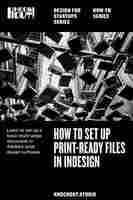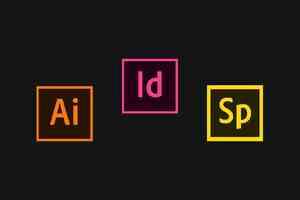Brochure Design Software: 3 Options Compared
How To Make A Brochure in CorelDRAW
Learning How-To Guides Make a Brochure
How To Make a Brochure
We are going to take a look at brochure design and see what is involved. A brochure is typically a folded piece of paper that can have anywhere from 1 - 4 folds. The most common is a single fold and a tri-fold. A single fold gives 2 panels (front and back) where a tri-fold gives 3 panels on both sides, although it only had 2 folds.
The most difficult part of this “how to” is to understand how to set up the document, and then the output.
How To Set Up Print-Ready Files in InDesign — Knockout! Studio
When creating multi-page documents, I almost always make a physical mockup before I begin. I highly recommend doing the same so that you can visualize the page order. In this video, I’ve folded and numbered each panel, so I know that I’ll be creating two spreads:

an outer spread with page 4 on the left, and the cover, page 1, on the right
an inner spread, with page 2 on the left and page 3 on the right
In this half-fold brochure, there are 4 pages, or, more accurately, 4 faces (not dissimilar to, though more interesting than, Mount Rushmore). This is important to understand as you create more complex folded documents, such as catalogs or lookbooks (the sort of things InDesign is intended for). Booklets such as those consist of, effectively, nested half-fold brochures, stapled in the middle. Since each of those “brochures” has 4 faces, no matter how many pages you add, your booklet page count will always be divisible by 4 (once again, math).
NOW BACK TO THE SIMPLE BROCHURE.
Setting up InDesign
If it’s your first time using InDesign, the units are probably defaulted to picas instead of inches or millimeters. Picas are a very useful measurement tool for serious typesetters, but not really something you need to know about until you’re deep in the book design world. To change your units to inches or millimeters, go to InDesign (or Edit on Windows) > Preferences > Units & Increments. Change the Horizontal and Vertical dropdown menus to inches (for US, Myanmar, and Liberia users) or millimeters (for users literally everywhere else). We’ll be using inches for this example. Note: This should only be a one-time adjustment. InDesign will remember your unit preferences for future documents.
Brochure Design Software: 3 Options Compared
Brochure Design Software: 3 Options Compared

So, you need to design a brochure? Where do you start? We’re comparing three different pieces of brochure design software to see how they stack up.
For web and digital designers creating a printed brochure for the first time, to designers that have been making print pieces for a while, using the right tool can make brochure design a more efficient task.
Choosing the right software, and sticking with it over time, is a sure-fire way to speed up your design workflow.
Adobe tools are the common starting place. Today, we’ll compare using InDesign, Illustrator and Adobe Spark (a free offering) as different options creating a brochure design.
We’ll look at the pros and cons of each (including the cost), and suggest which options are best for different types of brochure design project.
InDesign
Adobe InDesign is made for designing printed projects. Most designers go to InDesign first for any type of printed, multi-page layout because it is best suited for these kinds of projects.
From Adobe: “The industry-leading page design software and layout app lets you create, preflight, and publish beautiful documents for print and digital media. InDesign CC has everything you need to make posters, books, digital magazines, eBooks, interactive PDFs, and more.”
Pros of InDesign
Made for handling lots of text with styles for establishing rules for copy blocks
Master Pages functionality so you can create a common page set and apply it with one click
Tools that make page navigation easier such as indexing and automated contents
File handling and sizes is most efficient with InDesign because it only “contains” images from other places and does not embed them
Easy export to print-ready formats (as well as custom print settings)
Page setups allow for columns, grids, bleeds and print specifications
Direct brochure to online publication settings
Most downloadable templates come in InDesign format
Spread layouts let you see pages as connected units
Native files are generally accepted by many print shops (as are package files)
Great export compression, with multiple options
Cons of InDesign
Price, InDesign is part of the Creative Cloud suite and comes with a monthly subscription
Images, logos and graphics have to be imported from other places and remain linked to the file
Extensive software than can take some time to learn
Not usually the first thing designers learn when working with Adobe tools; Photoshop and Illustrator are more common with non-print designers
Illustrator
Adobe Illustrator is a vector-based tool that’s made for creating scalable illustrations. You can use it to create brochures – many designs do – but file and text handling features leave something to be desired for many users.
From Adobe: “The industry-standard vector graphics software lets you create logos, icons, drawings, typography, and illustrations for print, web, video, and mobile.”
Pros of Illustrator
Ease of use for designers that are comfortable with the software
Feeling of greater customization since you can draw and manage images inside files
Ease of creating odd or custom layouts, such as die-cuts
Better for brochures that are image-heavy and require repeated manipulation
Scalable files; create a brochure and reproduce it at any size
Cons of Illustrator
Price, Illustrator is part of the Creative Cloud suite and comes with a monthly subscription
Large file sizes since everything lives in the created file; they can grow to massive sizes
Page and spread management isn’t ideal here and you have to manually create page spread, grids and formatting
Extensive software than can take some time to learn
Export formats are not ideal for print publication
Adobe Spark
Spark is one of the newest software tools in the Adobe family and it comes with Creative Cloud subscriptions and in a free version. (The free version has a few limitations but is quite robust.) The primary function of Spark is to create simple online elements that can be adjusted and shared online.
From Adobe: “Spark is a free online and mobile graphic design app. Easily create beautiful images, videos, and web pages that make you stand out on social.”
Pros of Spark
Ease of use; Spark is intuitive and packed with starters to make design easy
Made for digital publishing (if that’ the format you plan to use for the brochure design)
Flexible format will change your design from one size to another with a click and few changes
Free
Plenty of trendy tools, such as image filters, styled text and animations
Software includes plenty of sharing tools
Make a brochure design into a simple website without code
Cons of Spark
Not made for multi-page format
Custom manipulation can get tricky
Not made for printed designs
Overall Assessment of Brochure Design Software Options
The brochure design software winner is Adobe InDesign. It’s just made for this type of job.
But it’s not that simple for all designers. There are other considerations to take into account.
When it comes to designing brochures, learning InDesign is worth the time.
If you are planning to do a lot of brochure design – print or digital, but especially print, learning InDesign is definitely worth your time if this isn’t a tool you are already using every day. If you don’t do a lot of this type of work and already know Illustrator, you can make it work using that software.
Adobe Spark isn’t really recommended for anything that needs multiple pages or actual printing.
But… then there’s thinking about when and where you’ll design brochures. InDesign and Illustrator are desktop-based design software tools; Spark is browser-based. (So, if you need something simple fast, Spark might be a viable alternative.)
If you are designing brochures from templates – that’s where many people start – pay attention to the formatting of the design. That can make your decision for you if you are set on a particular template. The brochure design templates often come as InDesign files, although there are Illustrator templates out there.
What it comes to down is what you are comfortable with using, and the time you have to complete the project. If you already know one type of software, that will probably be your go-to choice.
But when it comes to designing brochures, learning InDesign is worth the time. In the long run, it will help you create brochures faster (thanks to better tools for the job), save and export for printing with smaller files and be one more skill in your design repertoire.
Ready to begin your design? We have some great brochure templates to help you get a head start!